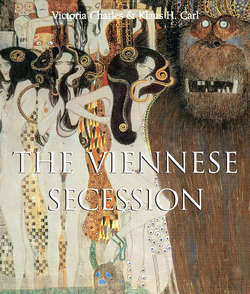Читать книгу The Viennese Secession - Victoria Charles - Страница 9
The Precursors of the Viennese Secession in Munich and Berlin
The Artists of the Munich Secession
ОглавлениеThe most important members of the Secession were, to mention a few, the first president of the movement, painter and sculptor Bruno Piglhein (1848–1894), as well as the painter, art-pedagogue, and teacher Ludwig von Herterich (1856–1932), who ultimately could never satisfy the high hopes that he had raised with his paintings Johanna Stegen and Ulrich von Hutten.
Franz von Stuck, one of the three “princes of painting of Munich”, a title he shared with Franz von Lenbach and Friedrich August von Kaulbach (1850–1920), was also a part of the group. Earlier, he made a name for himself as a gifted sculptor – which rightfully earned him the honour to be called one of the brightest and most talented artists that Munich could offer. Inspired by the opulent brutality of the baroque painters, by Arnold Böcklin’s (1827–1901) usage of intense colours, and by the rigid beauty of ancient sculptures, he developed his very own style of painting. Highly adaptable, he could apply his style strictly or freely to whatever motive he was painting: fantastical scenes, portraits, landscapes, or still-lifes. The grandeur of his style shows itself best in paintings such as Fangspiel (Faun und Nymphe) (Game of Tag – Faun and Nymph) (c. 1904), Kampf um eine Frau (Fight over a Woman) (1905), or Salome (1906).
Fritz von Uhde, who was the pioneer and trailblazer of the idea of plein air-painting in Munich, was also part of the group. Initially he was more famous for the controversial discussion that he regularly caused with his deeply emotional paintings that propagated a social interpretation of Christianity. Later he caught the attention of Munich’s art scene with his masterful solutions for technical composition problems in paintings. Since he approached the problems with a truly religious sentiment, the products were equal parts impressive and sentimental: Let the Children Come to Me (1884), Christ with the Peasants (1886), The Last Supper (1886) and Holy Night (1889). Beyond that, he also painted in a way that proved he possessed a keen gift for the observation of nature and the reality around him. Some apt examples are Bavarian Drummers (1883), The Nursery (1889), The Picture-Book (1889), and Darning (1890). Since Fritz von Uhde was also exhibiting with the Viennese Secession, Ludwig Hevesi reviewed his work as well:
Fritz von Uhde will also be among the celebrated. His grand Last Supper – which is preceded by its reputation from Munich – is one of his main, no, maybe his strongest achievement yet. […] In any case it is the most important of the master. Uhde returns to the light air of poetry from his beginnings, to those grave yet unspoken emotions which create an impression of the taboo. From this subtle poetry of the imponderable he moves towards tangible greatness […].
In later years, Uhde got tempted by the example of other artists to start using larger formats for his paintings. At the end of his life, Uhde was creating the most vivid and artistic paintings of his career. Interior scenes and landscapes that showed that he continously evolved in his style and had finally reaced the pinnacle of his mastery of painting. Rightfully he can be called one of the most important artists of the early 20th century.
Other artists that should be mentioned in this enumeration are painter Hans Thoma (1839–1924), Lovis Corinth (1858–1925), the Berlin impressionist Max Liebermann (1847–1935) and Hugo von Habermann (1849–1929), first vice-president, then president of the Secession. Some artists from Berlin joined the Secession in Munich as well, among others, portraitist Reinhold Lepsius, (1857–1922), Max Kruse, husband of the “Queen of Dolls”[4] Käthe Kruse (1854–1942), as well as Walter Leistikow (1865–1908), who later would create the Berliner Secession.
Yet, this group could not fulfil all expectations and did not remain a united body. They split into smaller groups several times, the most prominent being the Neue Secession from 1913. The Secession in Munich was dissolved in 1938 by the National Socialists during one of their “cultural cleansings”.
Franz von Stuck, Poster draft for the First International Exhibition of Art, “Homage to painting”, at the Glaspalast (detail), 1899.
Mixed technique on cardboard.
Museum Villa Stuck, Munich.
Franz von Stuck, The Sin, 1893.
Oil on canvas, 95 × 60 cm.
Neue Pinakothek, Munich.
Fritz von Uhde, Ascension (drawing), 1897.
Oil on canvas, 94.6 × 62.8 cm.
Bavarian State Painting Collection, Neue Pinakothek, Munich.
Fritz von Uhde, Woman, Why Weepest Thou? c. 1880.
Oil on canvas, 108.6 × 80.3 cm.
Charles and Emma Frye Collection, Frye Art Museum, Seattle, Washington.
Fritz von Uhde, The Picture Book I, 1889.
Oil on canvas, 61 × 49.5 cm.
Charles and Emma Frye Collection, Frye Art Museum, Seattle, Washington.
Fritz von Uhde, Nude study, c. 1890–1895.
Oil on canvas, 110.5 × 80 cm.
Museum der bildenden Künste, Leipzig.
Fritz von Uhde, Weinendes Mädchen (Young Woman Crying), 1893.
Pastel on cardboard, 26 × 20 cm.
Private collection. Courtesy of Galerie Konrad Bayer, Andechs, Munich.
4
A name she earned for her extraordinary skill at making dolls.
